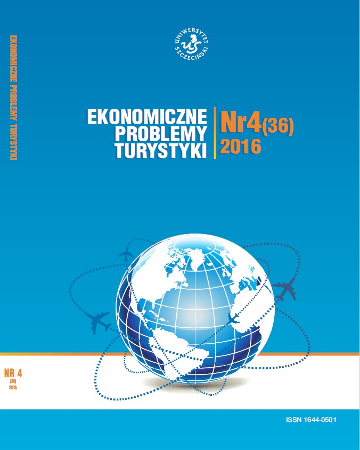
ISSN: 1644-0501
eISSN: 2353-3188
OAI
DOI: 10.18276/ept.2018.1.41-10



Issue archive /
nr 1 (41) 2018
Sezonowość w turystyce nadmorskiej - problemy lokalnych rynków pracy. Przykład województwa zachodniopomorskiego
(Corporate Social Responsibility in the Hotel Industry)
| Authors: |
Kamila
Radlińska
Politechnika Koszalińska |
| Keywords: | seasonality tourism labor market Granger causality |
| Data publikacji całości: | 2018-04-27 |
| Page range: | 10 (95-104) |
Abstract
Seasonality analysis was the basis for the attempt to identify the relationships of the unem-ployed in the Baltic communes with the unemployed in communes without access to the sea. The procedure allowed to answer the following questions: How different are the seaside labor markets in terms of the height and distribution of seasonal fluctuations in the number of unem¬ployed during the year and What kind of links connect the analyzed labor markets and what is the direction of these links. Seasonal components of unemployment were distinguished with the Census X-12 ARIMA algorithm. Relationship analysis was performed using Johansen’s test and Granger’s causality test. Data applied in the research concerned the monthly number of the unemployed in general from the period of January 2008-December 2016 obtained from the Voivodeship Labour Offices in Poland.
Download file
Article file
Bibliography
| 1. | Andriotis, K. (2005). Seasonality in Crete. Problem or a Way of Life?, Tourism Economics, 11 (2). |
| 2. | Drakatos, C. (1987). Seasonal Concentration of Tourism in Greece. Annals of Tourism Research, 14 (4). |
| 3. | Gruszczyński, M., Podgórska, M. (2004). Ekonometria. Warszawa: Szkoła Główna Handlowa w Warszawie. Grutkowska, S., Paśnicka, E. (2007). X-12 ARIMA i TRAMO/ SEATS - empiryczne porównanie metod wyrównania sezonowego w kontekście długości próby. Materiały i Studia, 220. |
| 4. | Hamilton, J. D. (1994). Time Series Analysis. New Jersey: Princeton University Press. |
| 5. | Higham, J., Hinch, T. (2002). Tourism, sport and seasons: The challenges and potential of overcoming seasonality in the sport and tourism sectors. Tourism Management, 23 (2). |
| 6. | Koźmiński C., Michalska B. (2016). Sezonowość i zmienność ruchu turystycznego w Polsce. Ekonomiczne Problemy Turystyki, 3 (35). |
| 7. | Kusideł, E. (2000). Modele wektorowo-autoregresyjne VAR metodologia i zastosowanie. W: B. Suchecki (red.), Dane panelowe i modelowania wielowymiarowe w badaniach ekonomicznych. Łódź: Absolwent. |
| 8. | Lee, C., Galloway, G., Bergin-Seers, S., O’Mahony, B., McMurray, A. (2008). Seasonality in Tourism Industry: Impacts and Strategies. Sustainable Tourism Pty Ltd. |
| 9. | Lim, C., McAleer, M. (2001). Monthly seasonal variations. Asian tourism to Australia. Annals of Tourism Research, 28, (1). |
| 10. | Majsterek, M. (1998). Zastosowanie procedury Johansena do analizy sprzężenia inflacyjnego w gospodarce polskiej. |
| 11. | Przegląd Statystyczny, XLV. |
| 12. | Martin, J.M., Fernandez, J.A., Martin, J.A., Aguilera, J. (2017). Assessment of the Tourism’s Potential as a Sustainable Development Instrument in Terms of Annual Stability: Application to Spanish Rural Destinations in Process of Consolidation. Sustainability, 9, 1692,DOI:10.3390/su9101692. |
| 13. | Orzeszko, W. (2012). Nieliniowa identyfikacja rzędu zależności w stopach zmian indeksów giełdowych. Przegląd Statystyczny, 59. |
| 14. | Sharpe, A., Smith, J. (2005). Labour market seasonality in Canada: Trends and policy implications, (1). Centre for the Study of Living Standards. |